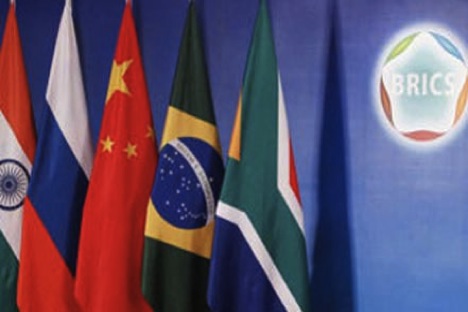
BRICS’ growth trajectory remains steady. Source: ITAR-TASS
The steady growth of the BRICS economies will impact their role in global affairs. Formed in 2008, following a well-publicised report of Goldman Sachs’ economist Jim O’Neill, the rising powers spreading over four continents have a GDP nearly equalling that of the US. Their rapid strides in development will widen the debate and prospects of a multi-polar cooperative structure in international scene in coming years.
Jim O’Neill in one of his letters on 4 December 2012 pointed out that the growth trajectory of the BRIC countries will remain intact. His estimation is that in the year 2012 these countries would register 6.1 per cent of growth, which will increase to 6.9 per cent in 2013. According to him, “We expect all the BRIC countries will perform better in 2013 than 2012… Collectively, we are expecting the BRIC countries to grow by 6.9 per cent up from a probable 6.1 per cent in year 2012.” While the BRICS would register relatively higher growth, the global economic growth rate will be much lower. According to O’Neill “We are forecasting the global growth at 3.6 per cent for the year 2013, and 4.1 per cent for year 2014.” The Goldman Sachs economist predicted that it will not be a matter of surprise if these countries’ economy collectively surpasses the US economy by the year 2014.
These developments in terms of forecasting of steady economic growth of the BRICS from a well-known economist belonging to a well-known economic entity from the US has impacts or at least will have a counter impact on the those analysts who were quick to predict doomsday to the economy of the grouping in the wake of financial crisis. Similarly, another revelation marks a crucial emerging trend. As per Goldman Sachs findings, investors prefer to bet on BRIC stocks over US stocks at the New York Stock Exchange. According to the business analyst, Joe Weisenthal, “one of the big themes of 2012 has been the outperformance of US exposure vs. foreign exposure. Now Goldman sees this reversing. Growth is expected to bounce back, and Goldman is above consensus in its BRIC growth estimates.” He further adds that it is not only Goldman Sachs but also many other agencies corroborate this trend.
One of the major criticisms in recent months is the lack of a common financial institution such as BRICS development bank to foster growth among these countries. Though the New Delhi BRICS summit mooted the idea, and there were also talks about pooling about $240 billion to realize the goal, the idea so far remained a non-starter. The good news in this regard is that South Africa’s Deputy International Relations and Cooperation Minister Marius Fransman revealed in the last week of November 2012 that by the time the next BRICS summit takes place, the BRICS development bank will likely be a reality.
The next summit is taking place in Durban, South Africa in March 2013. Most likely, the summit will announce the establishment and launching of the bank as a common pool of resources to aid the process of development within and outside of these countries. South Africa’s trade with other members of the grouping has doubled from 2005 to 2010, from $9.2 billion to $20.4 billion, and in the context of whole Africa the mutual trade between the continent and other members of the grouping is likely to reach one third of the continent’s total trade by 2015. Fransman also disclosed to the media that his country is planning to establish a think-tank to bolster the country’s relations with other members of the grouping for mutual benefit. Currently, as per 2012 estimates, about 3 billion people live in these five BRICS countries. Their combined GDP is about US$13.7 trillion and foreign reserves at about US$4 trillion. And these figures will grow in coming years.
It needs to be emphasised though that the BRIC was conceived as a group representing rising economies, it has gradually emerged as a champion of the global need of proliferation of decision making. The group has called for reform of global bodies like the United Nations, particularly the United Nations Security Council, and international financial bodies like the International Monetary Fund for the evolution of ‘fair and just world order.’
The New Delhi summit this year reiterated this multilateral approach to global problems. The balance of power is no more driven by a particular centre of power. The rise of BRICS and its rising economic muscle despite global financial crisis has made the grouping one of the major locus of international power. The grouping has already made its importance felt in global politics. More importantly, the members’ clout in other crucial bodies like G-20 and in regional forums like SCO has enhanced the role of the grouping. The news of their steady economic growth further adds to the trend that global decision making power is shifting.
The grouping, with the inclusion of South Africa in 2010, has emerged as an alternate pole of global power. There are differences between the members such as territorial disputes between India and China, but the political differences have taken a back seat in the process of increasing economic cooperation. Putting in another way, economic diplomacy has taken precedence over political differences. With their rising economic clout and with rising levels of awareness that war can no longer be a mechanism to resolve differences, the grouping has raised its stakes significantly in international politics.
Dr. Debidatta Aurobinda Mahapatra is an Indian commentator. His areas of interests include India-Russia relations, conflict and peace, and strategic aspects of Eurasian politics.
All rights reserved by Rossiyskaya Gazeta.
Subscribe
to our newsletter!
Get the week's best stories straight to your inbox